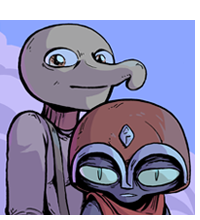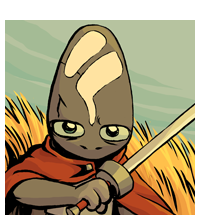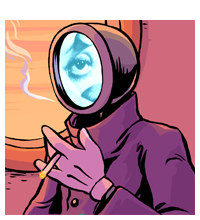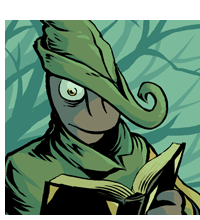 |
 |
 |
 |
 |
 |
 |
 |
You Can Never Catch Them AllThis is from November 2017. ETYMOLOGY Pokémon is a contraction of the Japanese name Poketto Monsutā; itself a composition of loanwords from English: Pocket, a small pouch or bag, usually sewn into clothing. As a verb, to pocket is to trivially take ownership of something; to steal it. Monster, an imaginary creature understood to be mysterious, frightening, and maybe supernatural. From the latin monstrum: an omen, a demonstration; or in a more specific usage, an aberration or mutation signifying a fault in nature itself. EXTRACTS But we don’t know everything about POKEMON yet. There are still many mysteries to solve. That’s why I study POKEMON every day. — OAK, Pokémon Gold, Silver, and Crystal. On the desk there is my invention, POKEDEX! It automatically records data on POKEMON you’ve seen or caught! It’s a hi-tech encyclopedia! To make a complete guide on all the POKEMON in the world… That was my dream! But, I’m too old! I can’t do it! — OAK, Pokémon Red, Blue, and Yellow. I see you’re using a POKEDEX. When you catch a POKEMON, POKEDEX is automatically updated. What? Don’t you know how to catch POKEMON? I’ll show you how to then. — NPC in Viridian City, Pokémon Red, Blue, and Yellow. I I was 8 or 9 when Pokémon first showed up in North America, and it was a thing shrouded in mystery. Japanese pop culture generally was accumulating cachet as a vast unfamiliar world that seemed to white southern 8- or 9-year-olds like me to have just emerged out of nowhere, or to have been struck like a vein of some mineral. More and more anime video cassettes showed up at the Blockbuster. The little import store in downtown Asheville had a pretty sizeable, if inconsistent, stock of totally mystifying plastic artifacts. A feeling on the continuum of culture shock: I lived in a rich and enormous pop culture, and I knew it well; I lived surrounded by it as no generation before mine ever had. And here was a whole other rich and enormous pop culture, foreign to me but still intelligible, still compelling and exciting and fun. More fun, even. How was it possible there could be so much of it? That’s what it felt like. I didn’t have any video games at that age, so Pokémon was learned exclusively through the social: watching kids play, talking about it, trying to accumulate some working knowledge of what it was, and particularly how many of them there were. And the conversations after school about the liminal spaces of the game, the folklore that turned out to be weirdly universal: the Mew under the truck, Pikablu the water-type Pikachu, endless arbitrary incantations to attain the Pokégods. Everyone seemed desperate to push the edges of this little glitchy playspace; to break into some more real area beyond it. By the time I played the games themselves, the mystery was already almost dead. II Pokémon has become the most profitable media franchise in the history of the world. Pokémon is a series of video games for children, the first pair of which came out in 1996, playable on the Nintendo handheld thing of the moment. There have been seven “generations” of these games, but as is the way of franchises, the first few iterations hemmed-in the space for all future games to occupy, allowing only the application of more and more bells and whistles. Pokémon is a series of iterations of a story of a child setting out alone into a wilderness and capturing and cataloguing every single creature that exists. There are 150 of them. You may hear rumors that there are more. The wilderness is a perfect grid; you can walk one square in one of the cardinal directions at a time. There are small towns, and people living viciously simple, poorly-translated lives. As you travel through tall grass or other gridded “wild” environments, you encounter a wild Pokémon at the behest of some random number generation algorithm. This is your encounter with the infinite complexity and chaos of nature, this random number generator. Using Pokéballs, you capture dozens of Pokémon with hundreds of “moves” and many different “types.” They are used for fighting in what is essentially an extremely complicated rock-paper-scissors game. A little hagiograph about Satoshi Tajiri, the man who conceived and led development of the original Pokémon games: in his childhood in a rural suburb of Tokyo called Machida, Tajiri would explore the woods and fields around his home collecting bugs. This was a consuming fascination, and he aspired to be an entomologist for some time in his youth before working in video games. The best any of us can hope for, maybe, is that the boundless anarchic fascinations of our early childhood can be pursued in adulthood by means of a preposterously successful corporate media enterprise. Machida was paved and incorporated into Tokyo’s dense urbanism by the late 70s. III Early in the game, you are given by Professor Oak, the Pokémon Prof., an electronic device called a Pokédex. As you collect Pokémon, your Pokédex becomes filled with little entries for each of them, including short text summaries (It’s never made clear whether you’re discovering them, or just going through the motions of cataloguing creatures found before you. Who wrote the 150 summaries? Professor Oak, the Pokémon Prof.?). Ishmael’s Pokédex is Chapter 32 of Moby-Dick, titled “Cetology.” This chapter is a sprawling taxonomy, and the first significant point of deviation from the book’s initial identity as a straightforward seafaring adventure novel. Ishmael’s taxonomy is opinionated, subversive… one might even be tempted to call it incorrect. The idea that whales are not fish is preposterous to Ishmael. He sets forth a catalogue of 14 canonical whales arranged according to size in three categories: The Folio Whale is for the largest whales, including the Sperm Whale. The Octavo Whale is for middle-sized whales. The Duodecimo Whale is for smaller whales or porpoises. Folio, octavo, and duodecimo are the names of standard book sizes. In this chapter Ishmael comfortably translates the vastness and the transcendent mystery of the whale into a thing manmade and readable. On board the Pequod, he plows through oceans, plucking whales from the water and boiling them down for oil for the furtherance of the nascent industrial world. We are assured that these creatures are understood; that our ever-increasing instrumentalization of the natural world is smiled upon. It ends up not going very well for the Pequod. IV You can catch all of the Pokémon. The number, remember, is 150. You have to trade with other kids over the “link cable” to get all of them. But you can do it. You can catch them all. And then what? One hundred more? Six more generations of games? At what point does the effort to articulate the numinous through ever-increasing numbers fail? What is the biggest number you can imagine? 151? 386? 802? When a new game comes out, there’s a predictable cycle of breathless searching for rumors that recalls the feeling of mystery that seemed to motivate the gameplay and after-school folklore in the early days. But the Japanese magazine scans get replaced pretty quickly with exhaustive peer-reviewed cataloguing in every major language on Bulbapedia, the for-real Pokédex. Everything, at last, is knowable. V Pokémon has always taken place in a delimited, Potemkin-village gameworld — if anything, the emptiness of the games’ settings has become more evident as the visual style has moved away from the flat, limited pixel art of the first first few generations. Maybe it’s this uncanny feeling of falsity that’s led to so much obsessive exploration of its liminal spaces, its secrets. First-generation glitches loom large: particularly MissingNo., the chaos-monster that emerged and could be captured like any Pokémon if you executed a particular magic ritual. It would create infinite copies of a rare item in your inventory, or corrupt your save file and your Gameboy forever, or who knows what. Did these elements of the Pokémon occult have such revelatory energy because of their sense of being truly secret, even secret from the games’ makers themselves? Was there some faint feeling of the contraband about them? The occult has vanished in the generations since that first cheap, glitchy pair of games. Instead, the mysteries allowable in Pokémon are those explicitly programmed-in, and breathlessly hyped along official channels. Each generation is in an arms race with the previous to introduce the most awe-inspiring “legendary” Pokémon. There is an alien virus, there are forces of nature, there are Ultra Beasts from another dimension, there is God. VI Mewtwo is Pokémon number 150: the last number given a Pokémon practically obtainable in the original games, encountered as the last intentional narrative event. Mewtwo’s story is a Frankenstein parable articulated through dark hints in ruined buildings in the games, and given extravagant literal form in Pokémon: the First Movie (1998). Mewtwo is the catastrophic result of genetic manipulation; an impossibly powerful bioweapon presented as a “playing God” story, but also, of course, as a formidable Pokémon to add to your collection. Mewtwo is Pokémon’s subtextual argument with its own premises, and its relationship to the apprehension and instrumentalization of nature. In the very first pair of games in the series, Pokémon presented its own shadow as the culminating moment of its story. You spend dozens of hours catching and battling Pokémon, filling the Pokédex with Pokémon 1 through 149, and achieving the greatest possible heights of Pokémon mastery. After the ostensible climax of the Champion battle, you can encounter the monster Mewtwo: the man-made abomination given the number 150, and thus incorporated into the rigid grid of a natural world rendered fully knowable and usable. Can you defeat it? Can you claim it as your own, and turn an emblem of humanity’s vain conquest of nature into an instrument of further conquest? Or will it destroy you, and trample your Pokédex under its foot? “And I only am escaped alone to tell thee.” Job. |